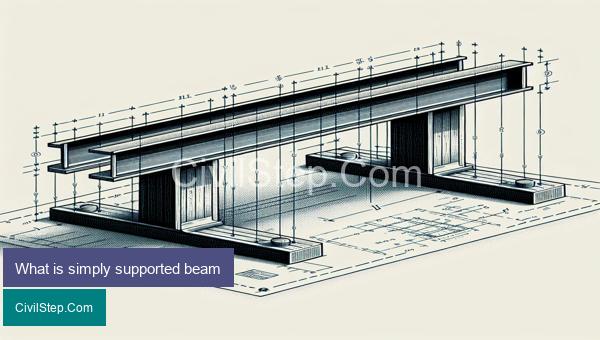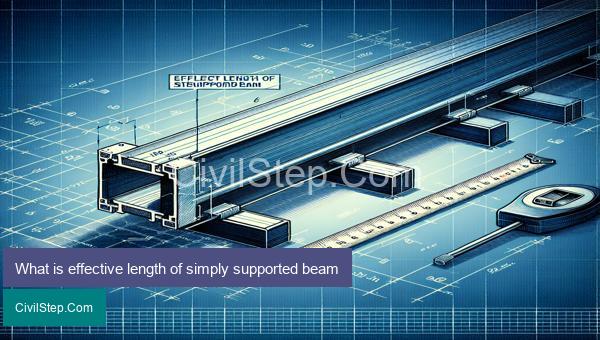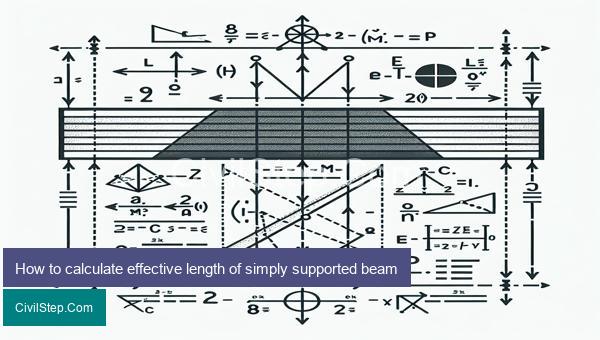
The determination of effective length for simply supported beams is an essential aspect of structural engineering. It refers to the calculation of the length of a beam that is required to act as a pin-ended support, thereby minimizing the bending moment and maximizing its load-carrying capacity. This article will provide a comprehensive overview of the factors that influence the effective length of a simply supported beam and discuss the different methods used to determine it. Understanding this concept is crucial for the design and analysis of various building structures, making it a key topic for engineers and architects alike.
Determination of effective length of simply supported beam

The effective length of a simply supported beam is a crucial factor in structural design and analysis. It refers to the distance between the points of zero bending in a beam, where the bending moment is zero. It plays a significant role in determining the behavior of a beam under load and is essential in calculating its deflection and buckling capacity. The effective length is influenced by various factors such as the type of supports, loading conditions, and the stiffness of the beam.
The effective length of a simply supported beam can be determined using two methods: theoretical and practical. The theoretical method involves solving complex mathematical equations based on the beam’s properties and boundary conditions. On the other hand, the practical method involves conducting experiments and tests on the beam to determine its effective length.
The theoretical method involves using the Euler’s column formula, also known as the Euler’s buckling formula, to calculate the effective length of the beam. It is based on the Euler buckling theory, which states that a slender column will buckle when the critical load is applied to it. The critical load depends on the column’s effective length, cross-sectional properties, and the material’s modulus of elasticity. By rearranging the Euler’s formula, the effective length of a simply supported beam can be calculated using the following formula:
Le=(Kl)/(√((π)^2)(E)(I))
Where,
Le = Effective length of the beam
K = Effective length factor (depends on the end support conditions)
L = Actual length of the beam
E = Modulus of elasticity of the material
I = Moment of inertia of the beam’s cross-section
The value of K depends on the type of end support conditions, which can be pinned or fixed. For a simply supported beam, the value of K is 1, as the end supports allow both rotation and translation.
The practical method involves conducting experiments on a scaled-down model of the beam to determine its critical load and effective length. The model is subjected to a gradually increasing load until the point of buckling, and the deflection is measured. By plotting the load versus deflection graph, the critical load and effective length can be determined.
Another practical method is to use the strain gauges to measure the strain in the beam under different loading conditions. The strain values can then be used to determine the effective length using the Euler’s formula.
In conclusion, the determination of the effective length of a simply supported beam is a crucial aspect of structural design. It requires a thorough understanding of the beam’s properties and boundary conditions. Engineers use both theoretical and practical methods to determine the beam’s effective length, ensuring the structural stability and safety of the beam under various loading conditions.
What is simply supported beam

A simply supported beam is a structural element that is commonly used in construction to support the weight of a roof, floor, or other loads. It is a horizontal beam that is supported at each end by either a column, wall, or another beam.
Simply supported beams are one of the most common and simplest types of beams used in construction. They are typically made of steel, wood, or reinforced concrete and are designed to span a distance between two supports.
The defining feature of a simply supported beam is that its ends are free to rotate and move vertically. This allows the beam to bend under load, creating a curve known as a deflection. The deflection is influenced by the load applied, the span of the beam, and its stiffness.
The load on a simply supported beam can be a combination of dead loads (e.g. the weight of the structure and its contents) and live loads (e.g. the weight of people, furniture, and equipment). The beam must be designed to safely support all these loads without excessive deflection.
The design of a simply supported beam takes into consideration several factors, such as the span of the beam, the load it will carry, the material it is made of, and the expected deflection. The strength and stiffness of the beam are determined by its cross-sectional shape and the type of material used.
One of the advantages of a simply supported beam is its ease of construction and installation. The two supports can be easily set up, and the beam can be placed in position. This type of beam also allows for easy maintenance and repair if necessary.
The most common application of simply supported beams is in building construction, where they are used in floors, roofs, bridges, and other structures. They are also used in industrial and commercial structures, such as warehouses and factories.
In conclusion, simply supported beams are an essential structural element in construction. They provide a safe and reliable way to support the weight of various structures and are relatively easy to install and maintain. Their versatility makes them a popular choice for various construction projects.
What is effective length of simply supported beam

The effective length of a simply supported beam is a fundamental concept in structural engineering. It is defined as the distance between the points of zero moment on a beam, and it plays a crucial role in predicting the behavior of a structure under different loading conditions.
In a simply supported beam, the ends are supported by hinges, allowing the beam to rotate freely. This results in a point of zero moment at each end, where the bending moment is equal to zero. The effective length is thus the distance between these points of zero moment.
The effective length of a simply supported beam is influenced by various factors such as the type of loading, the support conditions, and the end connections. For example, in a uniformly loaded beam supported at both ends, the effective length will be equal to the actual length of the beam. However, in a beam with one end fixed and the other end free, the effective length will be half of the beam’s actual length.
One of the main reasons for determining the effective length of a simply supported beam is to calculate its critical buckling load. When subjected to compressive forces, a beam can buckle, which can lead to structural failure. The effective length helps in determining the maximum load that a beam can withstand before it buckles.
Moreover, effective length is also crucial in determining the deflection of a beam. When a beam is subjected to external loads, it deflects or bends due to the applied forces. The effective length plays a vital role in calculating the beam deflection, which is crucial in designing structures that can withstand expected loads without excessive deflections.
In addition to the above, the effective length of a simply supported beam also affects the lateral stability of a structure. It determines the maximum allowable spacing between columns in a building design. A shorter effective length will result in increased stiffness and better stability, while a longer effective length will result in reduced stiffness and poorer stability.
In conclusion, the effective length of a simply supported beam is a critical parameter in structural engineering. It influences the load-carrying capacity, deflection, and stability of a structure. Therefore, it is vital for engineers to accurately determine the effective length when designing structures to ensure their safety and functionality.
How to calculate effective length of simply supported beam

Calculating the effective length of a simply supported beam is an important step in designing and analyzing the structural stability of a building or structure. It is a crucial parameter that directly affects the behavior and strength of a beam under different loading conditions.
The effective length of a simply supported beam can be defined as the actual length of the beam between its points of zero moment or points of inflection. In other words, it is the distance between the points where the beam bends or sags due to the applied loads.
There are several methods to determine the effective length of a simply supported beam, but the three most commonly used methods are the fixed-free method, the fixed-pinned method, and the effective length coefficient method.
1. Fixed-Free Method:
In this method, the beam is assumed to be fixed at one end and free to rotate at the other end. This method is used when the beam is connected to a rigid support on one end and is simply supported on the other end. The effective length of the beam in this method is equal to the actual length of the beam.
2. Fixed-Pinned Method:
In this method, the beam is assumed to be fixed at one end and pinned at the other end. This method is commonly used when the beam is connected to a rigid support on one end and has a pinned support on the other end. The effective length of the beam in this method is equal to half of its actual length.
3. Effective Length Coefficient Method:
This method is based on the concept that the actual length of a beam can be multiplied by a coefficient to determine its effective length. The coefficient value depends on the end conditions of the beam and is determined based on the beam’s flexibility.
The effective length coefficient for a simply supported beam can be calculated using the following formula:
Coefficient (K) = 2.0 – (0.60/n)
Where n is the number of inflection points in the beam.
For example, in a beam with only one inflection point (center of the beam), the coefficient value would be K= 2.0 – (0.60/1) = 1.40. This means that the effective length of the beam will be 1.4 times its actual length.
Similarly, for a beam with two inflection points (end and center), the coefficient value would be K= 2.0 – (0.60/2) = 1.70. This means that the effective length of the beam will be 1.7 times its actual length.
The effective length can also be calculated for beams with more inflection points, such as continuous beams, by using the same formula.
In conclusion, the effective length of a simply supported beam can be determined using various methods, such as the fixed-free method, the fixed-pinned method, and the effective length coefficient method. It is an essential factor in analyzing the stability and behavior of a beam under different loading conditions and must be accurately calculated to ensure the structural integrity and safety of a building or structure.
Conclusion
In conclusion, the determination of effective length for a simply supported beam is a crucial aspect in structural design. It plays a significant role in ensuring the stability and safety of the structure. By understanding the principles and factors that affect the effective length, engineers can make informed decisions in designing and selecting the appropriate beam length for a structure. With advancements in technology and ongoing research, the methods for determining the effective length are continuously improving. Therefore, it is important for engineers to stay updated with the latest developments in this field. Overall, determination of the effective length is an essential process in the design of simply supported beams and should not be overlooked. Through careful consideration and accurate calculations, a structure’s stability, functionality, and safety can be ensured.
